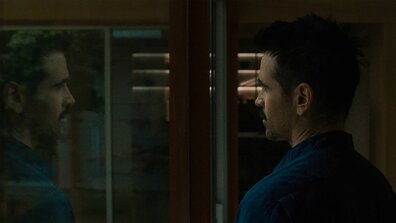
After Yang
Studio: A24
Director: Kogonada
Jan 27, 2022
Web Exclusive
![]()
It’s deeply ironic that Kogonada’s After Yang, a film dealing with the aftermath of a family losing their robot companion, happens to be one of the most human films in years. This paradox begins to make more sense when considering how the film’s sharp screenwriting and brilliant direction elevate an already fascinating premise to new heights.
After Yang opens by showcasing a family of four–parents Jake (Colin Farrell) and Kyra (Jodie Turner-Smith), their adopted Chinese daughter Mika (Malea Emma Tjandrawidjaja) and their adored robot companion Yang (Justin H. Min)–deep within their habitual nightly routine. Things quickly change, though, when Yang suddenly shuts down as a result of unexpected complications in his core. Mika is instantly heartbroken and Jake and Kyra are unsure of what to do, unable to get a refund because they purchased the robot secondhand. Jake begins to look for ways to fix Yang without having to send him back to his manufacturer.
In the midst of his search, Jake discovers that Yang was equipped with a memory box, able to capture a few seconds from each day that he was alive. While a curator at a technological museum that Jake meets wants the box in order to study Yang’s memories and display them in an exhibition, she gives Jake an adapter to watch the memories himself, giving him the choice to decide if he wants to participate. What follows is a spiritual journey not only for Jake himself but for all of those around him, including Yang, that emphasizes the power of memory and, in a broader sense, life itself.
One of the most interesting parts of watching After Yang is noticing how the film toys with its science-fiction roots. While science-fiction is baked into the very premise, the film also takes place in a futuristic world that doesn’t separate humans from nature, but rather, fuses the two together. This is especially emphasized through the film’s cinematography, which uses vivid colors and beautiful scenery, with an emphasis on plants and the natural world, to bring the surroundings around Jake and his family to life. As a result, the world that the characters occupy, as well as the dialogues they have with one another, consistently feel serene and calming, a tranquil escape that is a feast for the eyes as much as it is for the mind.
The film’s deconstruction of the science-fiction genre doesn’t stop at visuals. While Yang’s character may be a robot, his artificial intelligence isn’t mentioned very much. When it is, it is usually in reference to how he acted, and often discussed heavy concepts, in a deeply human way. This decision to refrain from commenting on the downsides, or even the complexities, of artificial intelligence quickly becomes one of the film’s greatest successes. Instead, Kogonada is fully focused on exploring how we experience and cope with universal emotions, including grief, love and connection, just to name a few.
While Jake’s journey working through these emotions may be what drives After Yang, the film’s scope is expansive. The film’s supporting characters have their own distinct personalities that make them both likable and easy to relate to. While their own journeys through grief get less screen time than Jake’s, they still provide varying looks at the ways in which we perceive, and understand, the things happening around us.
Although the film’s narrative contains many twists and turns, perhaps the most shocking part of After Yang is how the film deeply explores ideas such as the meaning of existence, passion and love using relatively simple characters and dialogue. Moreover, the film never feels manufactured or artificial. One of the reasons for this achievement, among many others, is the film’s core theme: The little moments in life are the ones that matter the most. By spotlighting both big moments in the character’s journeys as well as little habitual moments that are mundane yet beautiful, After Yang provides a complete and full portrait of human existence within the span of just 96 minutes. (festival.sundance.org)
Author rating: 8/10
Current Issue

Issue #72
Apr 19, 2024 Issue #72 - The ‘90s Issue with The Cardigans and Thurston Moore
Most Recent
- 12 Best Songs of the Week: Charly Bliss, Jessica Pratt, The WAEVE, Hamish Hawk, and More (News) —
- John Carpenter on ‘Lost Themes IV: Noir’ (Interview) —
- Thomas Powers (of The Naked & Famous) Shares New Single, “Empty Voices” feat. Julien Baker (News) —
- illuminati hotties Shares Video for New Song “Can’t Be Still” and Announces New Tour Dates (News) —
- Jordan Lindley Shares New Single “Sometime Someday” (News) —

Comments
Submit your comment
There are no comments for this entry yet.